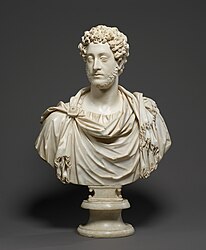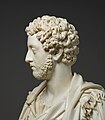File:Bust of Emperor Commodus, left profile - Getty Museum (92.SA.48).jpg

Original file (7,673 × 9,315 pixels, file size: 6.24 MB, MIME type: image/jpeg)
Captions
Captions
Summary
{{Information
Object
| Bust of Emperor Commodus
|
|||||||||||||||||||||||||||
|---|---|---|---|---|---|---|---|---|---|---|---|---|---|---|---|---|---|---|---|---|---|---|---|---|---|---|---|
| Artist | |||||||||||||||||||||||||||
| Title |
Bust of Emperor Commodus label QS:Len,"Bust of Emperor Commodus" |
||||||||||||||||||||||||||
| Object type |
sculpture |
||||||||||||||||||||||||||
| Genre |
bust |
||||||||||||||||||||||||||
| Description |
|
||||||||||||||||||||||||||
| Depicted people |
Commodus |
||||||||||||||||||||||||||
| Date |
between 180 and 185 date QS:P,+180-00-00T00:00:00Z/8,P1319,+0180-00-00T00:00:00Z/9,P1326,+0185-00-00T00:00:00Z/9 |
||||||||||||||||||||||||||
| Medium |
marble |
||||||||||||||||||||||||||
| Dimensions |
height: 69.9 cm (27.5 in) dimensions QS:P2048,+69.9U174728 dimensions QS:P2049,+61U174728 dimensions QS:P5524,+22.8U174728 |
||||||||||||||||||||||||||
| Collection |
institution QS:P195,Q180401 |
||||||||||||||||||||||||||
| Current location |
Gallery 207, Later Roman Sculpture |
||||||||||||||||||||||||||
| Accession number |
92.SA.48 (J. Paul Getty Museum) |
||||||||||||||||||||||||||
| Place of creation |
Rome |
||||||||||||||||||||||||||
| References |
J. Paul Getty Museum object ID: 103RSH |
||||||||||||||||||||||||||
Photograph
| DescriptionBust of Emperor Commodus, left profile - Getty Museum (92.SA.48).jpg | Bust of Emperor Commodus, left profile | ||
| Source |
The Getty Center, Object 103RSH
|
||
| Author | J. Paul Getty Museum | ||
| Permission (Reusing this file) |
|
||
| Other versions |
|
File history
Click on a date/time to view the file as it appeared at that time.
| Date/Time | Thumbnail | Dimensions | User | Comment | |
|---|---|---|---|---|---|
| current | 00:50, 6 March 2024 |  | 7,673 × 9,315 (6.24 MB) | DEGA MD (talk | contribs) | Uploaded a work by unknown maker from Getty Museum Collection with UploadWizard |
You cannot overwrite this file.
File usage on Commons
The following 10 pages use this file:
- File:Bust of Emperor Commodus, back - Getty Museum (92.SA.48).jpg
- File:Bust of Emperor Commodus, back detail - Getty Museum (92.SA.48).jpg
- File:Bust of Emperor Commodus, front - Getty Museum (92.SA.48).jpg
- File:Bust of Emperor Commodus, front detail - Getty Museum (92.SA.48).jpg
- File:Bust of Emperor Commodus, left detail - Getty Museum (92.SA.48).jpg
- File:Bust of Emperor Commodus, left profile - Getty Museum (92.SA.48).jpg
- File:Bust of Emperor Commodus, right detail - Getty Museum (92.SA.48).jpg
- File:Bust of Emperor Commodus, right profile - Getty Museum (92.SA.48).jpg
- File:Bust of Emperor Commodus, three-quarter detail - Getty Museum (92.SA.48).jpg
- File:Bust of Emperor Commodus, three-quarter profile - Getty Museum (92.SA.48).jpg
Metadata
This file contains additional information such as Exif metadata which may have been added by the digital camera, scanner, or software program used to create or digitize it. If the file has been modified from its original state, some details such as the timestamp may not fully reflect those of the original file. The timestamp is only as accurate as the clock in the camera, and it may be completely wrong.
| Author | The J. Paul Getty Museum |
|---|---|
| Image title |
|
| Short title |
|
| Source | The J. Paul Getty Museum |
| Usage terms | |
| JPEG file comment | Generated by IIPImage |
| Contact information | rights@getty.edu
www.getty.edu 1200 Getty Center Drive Los Angeles, California, 90049 United States |
| Date metadata was last modified | 10:33, 18 January 2020 |
| Copyright status | Copyright status not set |
- Template Unknown (author)
- Pages with complex technique templates
- Files from the Getty's Open Content Program
- Copyrighted free use
- Artworks with main subject different depicts
- Artworks with Wikidata item
- Artworks with accession number from Wikidata
- Artworks with known accession number
- Artworks main subject 3D work












